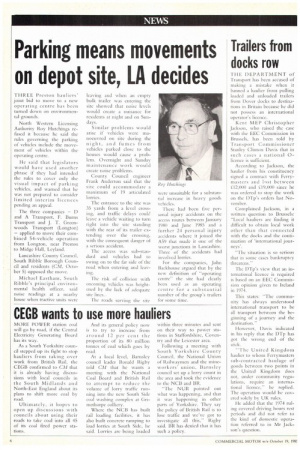Parking means movements on depot site, LA decides
Page 8

If you've noticed an error in this article please click here to report it so we can fix it.
THREE Preston hauliers' leaving and when an empty joint bid to move to a new bulk trailer was entering the operating centre has been site showed that noise levels turned down on environmenwould create a nuisance for nil grounds, residents at night and on Sun North Western Licensing Authority Roy Hutchings refused it because he said the rules governing the parking of vehicles include the movement of vehicles within the operating centre.
He said that legislators would have used another phrase if they had intended the rules to cover only the visual impact of parking vehicles, and warned that he was not prepared to consider
limited in licencespending an appeal.
The three companies — D and A Transport, F. Burns Transport and J. T. Greenwoods Transport (Lorigton) — applied to move their combined 54-vehicle operation from Langton, near Preston to Midge Hall, Leyland.
Lancashire County Council, South Ribble Borough Council and residents (CM, October 5) opposed the move.
Michael Eastham, South Ribble's principal environmental health officer, said noise readings at a nearby house when tractive units were days.
Similar problems would arise if vehicles were manoeuvred on site during the night, and fumes from vehicles parked close to the houses would cause a problem. Overnight and Sunday maintenance work would create noise problems.
County Council engineer Frank Anderton said that the site could accommodate a maximum of 19 articulated lorries.
The entrance to the site was 35 yards from a level crossing, and traffic delays could leave a vehicle waiting to turn right into the site standing with the rear of its trailer extending over the crossing, with the consequent danger of a serious accident.
The access was sub-standard and vehicles had to swing on to the far side of the road when entering and leaving.
The risk of collision with oncoming vehicles was heightened by the lack of adequate site lines., The roads serving the site
were unsuitable for 3 substantial increase in heavy goods vehicles.
'[here had been five personal injury accidents. on the access routes between January 1980 and June 1985 and a further 24 personal injury accidents where it joined the A59 that made it one of the worst junctions in Lancashire. Three of the accidents had involved lorries.
For the companies, John Backhouse argued that by the new definition of "operating centre" the site had clearly been used as an operating centre for a substantial number of the group's trailers for some time.




































































































